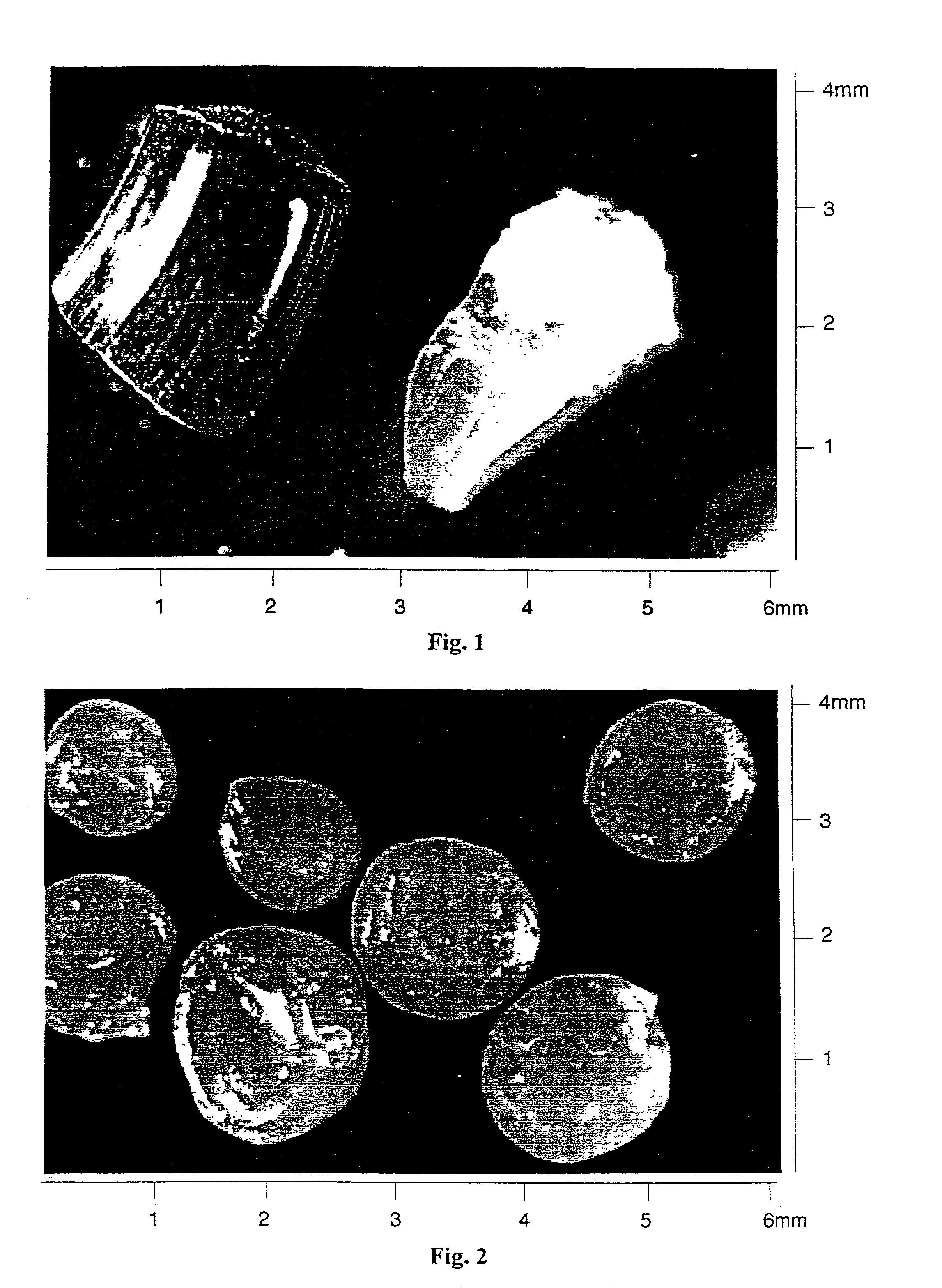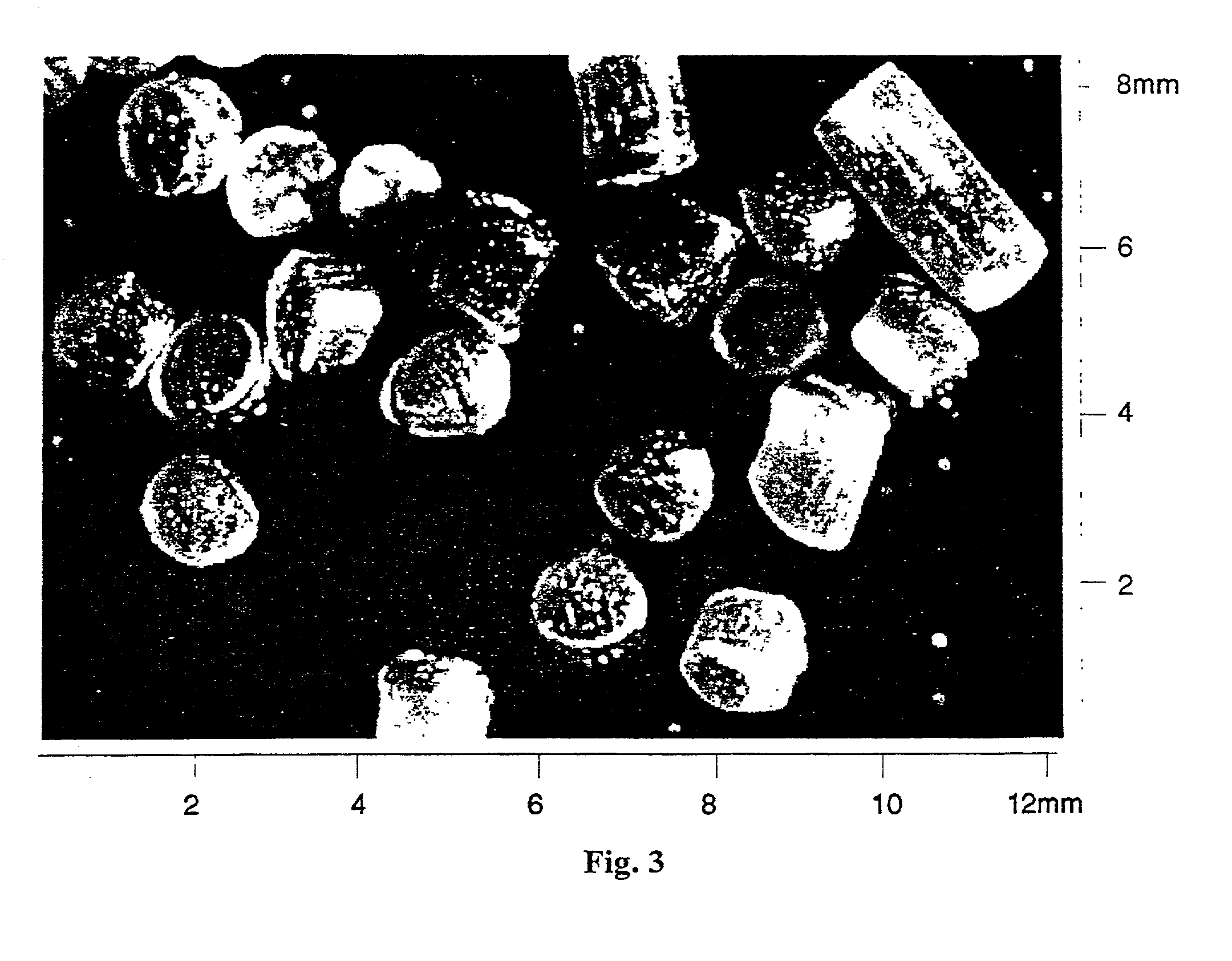Process for the preparation of granules for the controlled release of volatile compounds
a technology of volatile compounds and granules, which is applied in the field of process for the preparation of granules for the controlled release of volatile compounds, can solve the problems of undesirable variations, loss of volatile components, and difficult to ensur
- Summary
- Abstract
- Description
- Claims
- Application Information
AI Technical Summary
Problems solved by technology
Method used
Image
Examples
example 2
[0060] A spray-dried formulation was prepared by admixing the following ingredients:
2 Ingredients Parts by weight Orange flavor.sup.1) 10 Lecithin 1 Water 7 Maltodextrin 19 DE 82 Total 100 .sup.1)502164 T; origin: Firmenich SA, Geneva, Switzerland
[0061] The powder was extruded at a throughput of 50 kg / h through 1 mm die holes using a Clextral BC 45 twin-screw extruder equipped with a cutterknife allowing to chop the melt at the die exit while it is still plastic. At the low water content needed to guarantee a glass transition above 40.degree. at constant sample composition, the temperature of the melt in the front plate was of 105.degree. and the static pressure in the extruder was preferably kept below 1-20.times.10.sup.5 Pa.
example 3
[0062] A dry blended formulation was prepared by admixing the following ingredients:
3 Ingredients Parts by weight Fragrance 3 Silicone dioxide 2 Lecithin 1 Water 7 Maltodextrin 19 DE 87 Total 100
[0063] The powder blend was extruded at a throughput of 5 kg / h through 2 mm die holes using a Clextral BC 21 twin screw extruder equipped with a cutterknife allowing the chopping of the melt at the die exit while it is still plastic. At the low water content needed to guarantee a glass transition above 40.degree. at constant sample composition, the temperature of the melt in the front plate was of 105.degree. and the static pressure in the extruder was preferably kept below 20.times.10.sup.5 Pa.
[0064] The fragrance used in the above composition was obtained by admixture of the following ingredients:
4 Ingredients Parts by weight 1-Pentyl-2-propenyl acetate 10 Hexylcinnamic aldehyde 250 Cetalox .RTM..sup.1) 5 Tricyclo[5.2.1.0(2,6)]dec-3,4-en-1-yl acetate 90 Coumarine 10 2-Pentyl-1-cyelopentano...
example 4
[0065] Comparative Example of the Size Distribution of Particles Manufactured According to Different Methods
[0066] The following table shows the size distribution of particles manufactured respectively using (i) spray-drying, (ii) leaflash drying, (iii) multistage drying, (iv) glass-granulation using a 1.5 mm mesh size in the breaker and (v), (vi), (vii) granulation according to the present invention. More particularly, the size distribution of particles prepared according to the method described in examples 1, 2 and 3, is reported in columns (v), (vi) and (vii) respectively.
5 Weight fraction [%] Mesh Size [mm] (i) (ii) (iii) (iv) (v) (vi) (vii) 2.000 0 0 0 0 0 0 85 1.400 0 0 0 70 0 95 13 1.000 0 0 0 54 0 5 2 0.700 0 0 0 8 67 0 0 0.500 0 0 6 7 28 0 0 0.250 0 14 42 5 5 0 0 0.150 0 26 43 3 0 0 0 0.075 20 24 9 3 0 0 0 0-0.075 80 35 0 3 0 0 0
PUM
 Login to View More
Login to View More Abstract
Description
Claims
Application Information
 Login to View More
Login to View More - R&D
- Intellectual Property
- Life Sciences
- Materials
- Tech Scout
- Unparalleled Data Quality
- Higher Quality Content
- 60% Fewer Hallucinations
Browse by: Latest US Patents, China's latest patents, Technical Efficacy Thesaurus, Application Domain, Technology Topic, Popular Technical Reports.
© 2025 PatSnap. All rights reserved.Legal|Privacy policy|Modern Slavery Act Transparency Statement|Sitemap|About US| Contact US: help@patsnap.com


